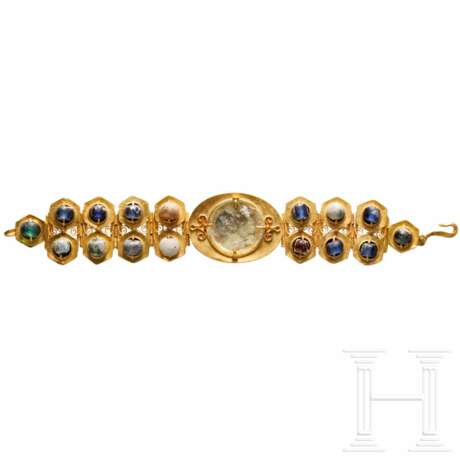ID 1323335
Lot 4124 | Frühbyzantinisches Gliederarmband aus Gold mit Glaseinlagen, 5. - 7. Jhdt.
Armband aus zehn Gliedern, die durch Röhrenscharniere beweglich miteinander verbunden sind. In der Mitte eine 6 mm hohe, hohle, ovale Kastenfassung, deren Seiten sich nach unten hin zur rückseitigen Platte konisch verjüngen. Auf der Oberseite ein rundes Glasscheibchen, von vier Drahtklammern gefasst und von einem Goldddraht umgeben. An den Schmalseiten zusätzlich Voluten aus Golddraht mit einer Granalie darüber. Unter der Scheibe im Kasten ein rundes Loch. Der Kasten ehemals wohl mit Kitt aus organischem Material gefüllt. Seitlich des zentralen, ovalen Glieds auf einer Seite vier, auf der anderen fünf Glieder. Diese bestehen aus ähnlich konstruierten, hexagonalen Kastenfassungen für Glasperlen. In der Mitte jeweils ein von einem Draht umgebenes Loch, in dem die von einem schmalen Goldblechstreifen gehaltenen Perlen seitlich an den das Loch umgebenden Draht gelötet sind.
Die äußersten Glieder bestehen aus einem Hexagon, die inneren Glieder aus je einem Paar Hexagone, zwischen die je eine S-förmige Spirale aus Golddraht mit einer Granalie zwischen den beiden Windungen eingefügt ist. Die Perlen aus grünem, weißem, blauem und rötlich gefärbtem Glas, teils mit einer schillernden "Iris" bedeckt. An den äußeren, einfachen Gliedern einmal ein beweglicher Haken in einem Röhrenscharnier und auf der gegenüberliegenden Seite eine Drahtöse als Pendant für den Haken zum Verschließen des Armbands. Länge des geöffneten Armbands 16 cm. Gewicht 36,40 g. Ausgesprochen schönes und nahezu perfekt erhaltenes spätantikes Schmuckstück, wohl für ein Mädchen der Oberschicht des spätrömischen bzw. frühbyzantinischen Mittelmeerreichs.
An early Byzantine gold bracelet with glass inlays, 5th - 7th century
An early Byzantine gold bracelet with glass inlays, 5th - 7th century
Bracelet consisting of ten links that are connected to each other by tubular hinges. In the centre, a 6 mm high, hollow, oval box setting, the sides of which taper downwards towards the plate on the back. A round glass disc on the top, set with four wire clips and surrounded by gold wire. On the narrow sides, additional volutes of gold wire with a garland above. A round hole in the box under the disc. The box was probably once filled with putty made of organic material. Four links on one side of the central oval link, five on the other. These consist of similarly constructed hexagonal box settings for glass beads. In the centre of each link is a hole surrounded by a wire, in which the beads, held by a narrow strip of sheet gold, are soldered to the sides of the wire surrounding the hole.
The outermost links consist of a hexagon, the inner links of a pair of hexagons, between each of which an S-shaped spiral of gold wire is inserted with a granule between the two coils. The beads are made of green, white, blue and reddish coloured glass, partly covered with an iridescent "iris". A movable hook in a tubular hinge on one of the outer, simple links and a wire loop on the opposite outer link as a counterpart for the hook to close the bracelet. Length of the open bracelet 16 cm. Weight 36.40 g.
An exceptionally beautiful and almost perfectly preserved piece of late antique jewellery, probably for a girl of the upper class of the late Roman or early Byzantine Mediterranean Empire.
Condition: I - II
| Auction house category: | Byzantium and the Middle Ages in Southeastern Europe |
|---|
| Auction house category: | Byzantium and the Middle Ages in Southeastern Europe |
|---|
| Address of auction |
Hermann Historica Bretonischer Ring 3 85630 Grasbrunn / München Germany | ||||||||||||||
|---|---|---|---|---|---|---|---|---|---|---|---|---|---|---|---|
| Preview | |||||||||||||||
| Phone | +49 (0)89 5472 649 0 | ||||||||||||||
| Fax | +49 (0)89 5472 64999 | ||||||||||||||
| Buyer Premium | 25 % | ||||||||||||||
| Conditions of purchase | Conditions of purchase | ||||||||||||||
| Business hours | Business hours
|



